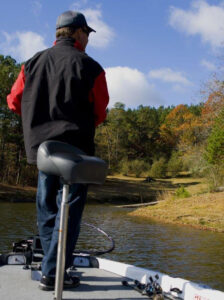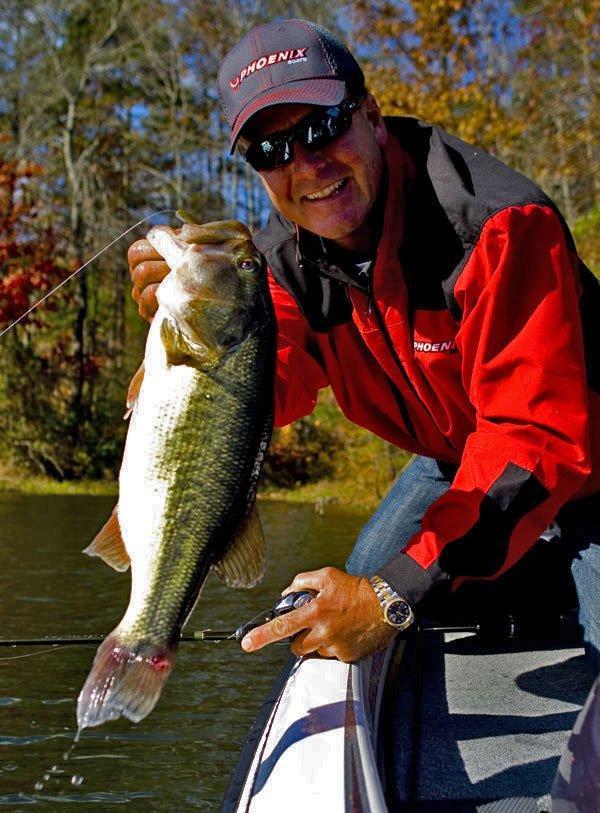Spring bass fishing presents anglers with the opportunity to catch some of the biggest bass of the year. As the bass begin to vacate their deep, wintertime homes in search of shallower water throughout the prespawn, Phoenix Boats pro Davy Hite studies one element more so than others—water temperature.
Some of us have fancy machines on our boats that figure that stuff out for us, so it should be simple enough, right? Unfortunately, it’s not as cut-and-dry as hopping in your boat, checking your graph and going fishing. Throughout the prespawn, Hite places more merit on past and future water temperature than he does current temperatures.
Bass aren’t like us
Whenever we hit the lake on a chilly morning, we usually don’t think much about it—a quick search through your boat to find an extra jacket is all it takes to keep your core body temperature at the important 98.6-degree mark. It’s important to understand, however, that the body temperature of cold blooded bass fluctuates, making them especially susceptible to small changes in temperature.
“A lot of people overlook the correlation between water temperature and bass behavior,” Hite said. “We should never forget that bass are cold blooded, making water temperature a huge factor in how lethargic or aggressive they might be.”
Bass are always adjusting to the water temperature, which makes past and future water temperatures more relevant to them than the current conditions. For this reason, Hite doesn’t let current temperatures dictate how he goes about finding large concentrations of bass.
“If you’re making a game plan solely based on the current water temperature without researching the previous conditions, you’re making a big mistake,” Hite said. “I always want to make sure I know the past and future forecasts for the lake I’m fishing.”
Falling water temperatures
You were wearing them out last week—60 degree water, sunshine and a nice breeze helped you catch a sack full of big largemouth. This weekend is much different however. After a mild cold snap rolls through your favorite lake, you’re now dealing with 55 degree temperatures, cranky bass and an empty livewell. 5 degrees can’t make that much of a difference, can it? Hite begs to differ.
“Prespawn water temperatures in the 55-degree range sound great, but it can make for some tough fishing if the fish were previously acclimated to 60 degree water,” Hite said. “In these conditions, I like to look for shallow water with adjacent deep water and focus on the break lines.”
In falling prespawn water temperatures, bass won’t move too far from their preferred shallow dwellings, but they will slide back into deeper water and suspend until they’re adjusted to the current conditions. Hite relies on a Rapala Husky Jerk or a Trigger X Drop Dead Minnow to target these fickle bass.
“I want to use baits that can get down to the middle of the water column and stay in the strike zone for as long as possible,” Hite said. “If you parallel the break lines with slow falling or suspending baits, you can catch those fish that were previously shallow.”
Rising water temperatures

Prespawn warming trends can turn into outrageous fishing days. As the water continues to warm, you can expect bass to utilize shallow cover and become much easier to catch.
“When the water temperature is on the rise, I’ll still target the same shallow water areas near deep water, except now I will really focus on shallow cover, whether it’s blowdowns, stumps or docks,” Hite said. “If that sun comes out and really starts to warm up the water, look for big bass chomping at the bit to feed.”
If Hite notices a warming trend in the immediate forecast, he breaks out his secret weapon—a paper map. On this map, he’ll search for inside and outside creek channel bends. After locating several promising areas, he’ll get on the water and scour the areas for the best available shallow cover. When he runs across shallow cover with deep water nearby, he breaks out his favorite prespawn bait—a Buckeye Lures Mop Jig.
“There’s no doubt in my mind that a Mop Jig is the best prespawn big fish bait I’ve ever thrown,” Hite said. “I think the longer, thicker living rubber is a big deal to these aggressive prespawn bass. Whether you’re fishing in a slight breeze or current, the jig just sits down there and waves around right in their face. It’s absolutely deadly.”
Early spring bass fishing is phenomenal if you can get in the habit of paying attention to past and future conditions. Knowing where the water temperature has been and where it’s going can give you a big competitive advantage as the bass move throughout the water column to adjust to changing water temperatures.












